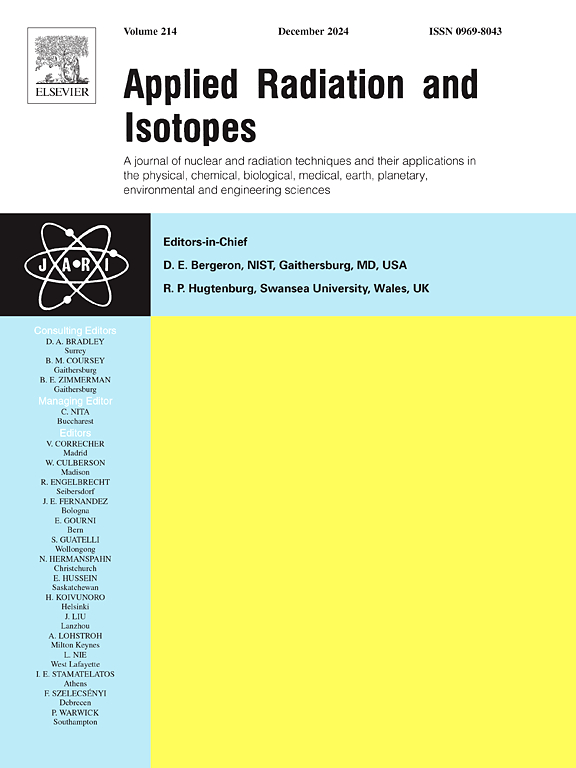不同手术方式对乳腺癌患者放疗期间肺平均剂量的比较研究
IF 1.8
3区 工程技术
Q3 CHEMISTRY, INORGANIC & NUCLEAR
引用次数: 0
摘要
乳腺癌(BC)是影响全世界妇女的一种高度普遍和重大的健康问题。这对于了解乳腺癌的影响和制定有针对性的预防和治疗策略至关重要。本研究旨在通过比较BCS和MRM方案在平均肺剂量方面的性能,探讨3DCRT模型的性能。目的对MRM和BCS治疗方案进行比较分析,以确定最适合乳腺癌的治疗策略,重点是尽量减少对肺部的辐射剂量。方法与材料对174例乳腺癌(BC)患者进行放疗。将BCS的治疗方案与基于平均剂量肺和靶覆盖率的MRM方案进行比较。为制定乳腺癌3DCRT治疗方案,在摩纳哥应用3DCRT治疗并评价乳腺癌放疗效果,分析BCS和MRM治疗方案的主要剂量学参数。本研究根据手术类型将患者分为保乳手术组(breast- conservation surgery, BCS)和改良根治性乳房切除术组(modified radical mastectomy, MRM)两组。每组还根据放疗剂量(4050、4256、5000 cGy)以及是否照射腋窝和锁骨上淋巴结划分为不同的亚组。根据PTV的大小,执行不同的策略方案以获得最佳效果。MRM处方剂量为4050 cGy、270 cGy/分(270 cGy/Fx)、4256/16分;BCS处方剂量为5000 cGy、200 cGy/分(200 cGy/Fx)、4050/15分270 cGy/分(270 cGy/Fx)。ResultsThe本研究的患者总数是174乳腺癌患者年龄从18岁到77岁平均±标准差(49.2±11.5)岁,和结果显示乳腺癌患者中发病率最高的6日50(59岁),他们(29.3%)和第五和第七数十年的生活,(23.5%),而乳腺癌患者中发病率最低的3日十年(低于1%)。本文章由计算机程序翻译,如有差异,请以英文原文为准。
Comparative study of mean lung dose with different types of surgery in breast cancer patients during radiotherapy
Breast cancer (BC) is a highly prevalent and significant health concern influencing women worldwide. This is crucial for understanding the impact of breast cancer and developing targeted prevention and treatment strategies. The research aims to investigate the performance of the 3DCRT model by comparing BCS and MRM plans in terms of mean lung dose.
Purpose
A comparative analysis of MRM and BCS treatment plans was conducted to determine the most appropriate strategy for breast cancer, with an emphasis on minimizing radiation dose to the lungs.
Methods and materials
Breast cancer (BC) RT was performed for 174 patients’ treatment planning. The treatment plans for BCS are compared to the MRM plans based on mean dose lung and target coverage. To create a 3DCRT plan for Breast cancer, applying 3DCRT in Monaco and evaluating an outcome of Breast cancer irradiation procedure, analyse the main dosimetric parameters of the planned treatment plans for BCS and MRM plans. This study divided the patients into two groups according to the type of surgery breast-conserving surgery (BCS) and modified radical mastectomy (MRM) groups. Each group is also divided into different subgroups according to the dose of radiotherapy given (4050, 4256, and 5000 cGy) and whether the lymph nodes in the axillae and the supraclavicular regions are irradiated or not have been taken into account. Different strategy plans were performed to get the best result according to the size of the PTV. The dose Prescribed for MRM was 4050 cGy, 270 cGy per fraction (270 cGy/Fx), 4256/16 fraction while BCS was 5000 cGy, 200 cGy per fraction (200 cGy/Fx), 4050/15 fraction 270 cGy per fraction (270 cGy/Fx).
Results
The total number of patients in this study was 174 breast cancer patients with ages ranging from 18 to 77 years with a mean age ± SD (49.2 ± 11.5) years, and the results showed the highest incidence of breast cancer among patients in 6th (50–59 years) and they are (29.3 %) and the 5th and 7th decades of life and (23.5 %) each, while the lowest incidence of breast cancer among patients in 3rd decade of life (below 1 %).
求助全文
通过发布文献求助,成功后即可免费获取论文全文。
去求助
来源期刊

Applied Radiation and Isotopes
工程技术-核科学技术
CiteScore
3.00
自引率
12.50%
发文量
406
审稿时长
13.5 months
期刊介绍:
Applied Radiation and Isotopes provides a high quality medium for the publication of substantial, original and scientific and technological papers on the development and peaceful application of nuclear, radiation and radionuclide techniques in chemistry, physics, biochemistry, biology, medicine, security, engineering and in the earth, planetary and environmental sciences, all including dosimetry. Nuclear techniques are defined in the broadest sense and both experimental and theoretical papers are welcome. They include the development and use of α- and β-particles, X-rays and γ-rays, neutrons and other nuclear particles and radiations from all sources, including radionuclides, synchrotron sources, cyclotrons and reactors and from the natural environment.
The journal aims to publish papers with significance to an international audience, containing substantial novelty and scientific impact. The Editors reserve the rights to reject, with or without external review, papers that do not meet these criteria.
Papers dealing with radiation processing, i.e., where radiation is used to bring about a biological, chemical or physical change in a material, should be directed to our sister journal Radiation Physics and Chemistry.
 求助内容:
求助内容: 应助结果提醒方式:
应助结果提醒方式:


